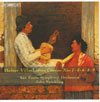Villa-Lobos Choros, Vol. 2
The Brazillians go to town with the music of their home-grown hero
View record and artist detailsRecord and Artist Details
Composer or Director: Heitor Villa-Lobos
Genre:
Orchestral
Label: BIS
Magazine Review Date: 10/2008
Media Format: CD or Download
Media Runtime: 0
Mastering:
Stereo
Catalogue Number: BISCD1450

Tracks:
| Composition | Artist Credit |
|---|---|
| Chôros No. 1 |
Heitor Villa-Lobos, Composer
Fabio Zanon, Guitar Heitor Villa-Lobos, Composer |
| Chôros No. 4 |
Heitor Villa-Lobos, Composer
Dante Yenque, Horn Darrin Coleman Milling, Bass trombone Heitor Villa-Lobos, Composer Ozéas Arantes, Horn Samuel Hamzem, Horn |
| Chôros No. 6 |
Heitor Villa-Lobos, Composer
Heitor Villa-Lobos, Composer John Neschling, Conductor São Paulo Symphony Orchestra |
| Chôros No. 8 |
Heitor Villa-Lobos, Composer
Heitor Villa-Lobos, Composer Ilan Rechtman, Piano John Neschling, Conductor Linda Bustani, Piano São Paulo Symphony Orchestra |
| Chôros No. 9 |
Heitor Villa-Lobos, Composer
Heitor Villa-Lobos, Composer John Neschling, Conductor São Paulo Symphony Orchestra |
Author: Guy Rickards
Whenever it was set down, the Sixth is a hugely engaging, if sprawling, orchestral fantasia and like the Eighth (written and premiered between 1925 and 1927) and Ninth, was scored for large orchestra using exotic local percussion instruments. The Eighth is far more barbaric in character, tailored for the fad for primitivism then fashionable in Paris (where it was written), with parts for two pianos. Yet this is no concerto in disguise; although the first is a melodic soloist, the second is deployed as a percussive instrument and both orchestrally. BIS provides a clearer balance than Marco Polo on Schermerhorn’s pioneering account and while the latter still sounds fine, the newcomer is clearly superior.
Neschling and the São Paulo SO edge the decision in the Ninth too, which lies expressively between Nos 6 and 8. Separating these difficult orchestral works come the First for guitar (1920‑21) and Fourth for brass (1926). I have heard crisper performances of the latter, but Fabio Zanon’s of the well known First is really rather good, languid and wistful, the tempi vibrantly elastic. After the excellent previous volume (6/08), this successor – as well played as ASV’s still incomplete rival survey – augurs well for what will presumably be the final instalment.
Explore the world’s largest classical music catalogue on Apple Music Classical.
Included with an Apple Music subscription. Download now.

Gramophone Digital Club
- Digital Edition
- Digital Archive
- Reviews Database
- Events & Offers
From £9.20 / month
Subscribe
Gramophone Club
- Print Edition
- Digital Edition
- Digital Archive
- Reviews Database
- Events & Offers
From £11.45 / month
Subscribe
If you are a library, university or other organisation that would be interested in an institutional subscription to Gramophone please click here for further information.






